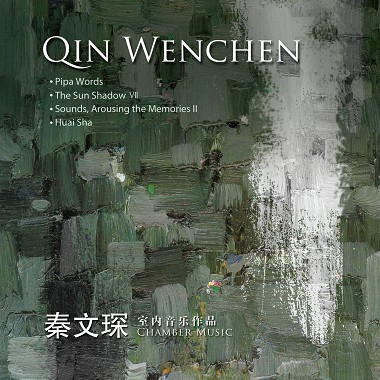
秦文琛室内乐作品
- 歌手名:
- 语种:纯音乐
- 介质:CD
- 碟数:1张
- 发行日期:2010
专辑简介
《琵琶辞》 (2006)
为独奏琵琶写作的琵琶辞是为了回应好友Julian Yu。
乐曲开始的泛音象晶莹的水珠在阳光下,折射出斑斓的光彩。之后如涓涓溪流汇集成大河,奔向大海而归于平静。全曲要求演奏一气呵成。
关于《太阳的影子Ⅶ》(2005)
《太阳的影子Ⅶ》是《太阳的影子》系列作品的第七首。这组作品全部是为了作者童年时对于草原的记忆。《太阳的影子Ⅶ》更多地表达出在蒙古草原上,人们心灵所感受到的直率、狂野、孤独、永恒的静穆以及遥远的意向……。乐曲结束处的大提琴奏法为秦文琛所独创,在此大提琴奏出“行走的主题”。“行走的主题”以不同的方式贯穿在秦文琛的多部作品中
《唤起记忆的声音Ⅱ》(2008)
声音在巨大的空间中延伸,无始、无终……..。
乐曲中锣的音色总是代表着人的情感,它是细致、多变的。锣也常常作为一个独立的“角色”从其他的音色中分离出来。乐曲的结束 锣急迫而多变的声音飘荡在一个寂静寥落的音响空间中,好似“独舞苍茫天地间”。
先后三次出现在乐曲中的一个二度主题,分别表示出人的呼唤,呐喊和吟唱。
《怀沙》(1999)
本乐曲系为纪念中国古代著名诗人屈原(公元前340-278)而作,曲名取自其同名诗《怀沙》。
为长篇抒情诗《离骚》所震撼,曲作者还在乐曲中融入了该诗篇中所表现的“众鸟惊飞”的印象,这是屈原的另一篇震铄古今的巨制鸿篇,其中体现出的艺术想象可谓天马行空、气往轹古。
乐曲中运用了一个五声音阶,这个音阶分别在乐曲的开始、中间段落和乐曲结尾中运用,表达出三种不同的心境。
乐曲从后半部分开始,每一件乐器都按自己的运动方向和速度行进,从而构成了一个巨大的、运动着的音响空间,直到乐曲进入了由若干个固定的音响色块直接拼贴而成的高潮段落中。这种色块的拼贴法,其灵感正是来源于屈原诗歌中不同意象的直接对峙的手法。这些色块对比强烈,并以递减的方法重复,因而造成了音乐极大的紧张度。
Pipa Words (2006)
Pipa Words, a solo specially composed for the instrument pipa, is dedicated to my best friend Julian Yu.
The music begins with overtones like running water beads glittering with colors from the sun. The water beads gradually come together into brooks, and then into a huge stream that roars toward and vanishes in the sea.
The composition is played as a coherent whole without any intermission.
SHADOW OF THE SUN VII (2005)
This composition emphasizes the expression of certain conditions of the Mongolian steppe that the composer feels in his heart – the simple, wild, lonely, eternal and solemn quietness, the perception of remoteness, and more.
Sounds, arousing the memories Ⅱ(2008)
The sky in the vast grassland is broad and quiet. In such quietness, people can hear the natural sounds of heaven and earth, while seeing huge shadow projected by clouds moving ahead. In such quietness, you may also feel the strength. These are my childhood memories of the grassland. “Sounds, arousing the memories” is composed to express such mood of nostalgia.
In the music, the rhythm of gongs, which can always represent people's feelings, appears three times in the second theme, showing respectively the calling, crying and moaning of a person (the three mythos starts respectively from bar 76, 105 and 128 of the score).
HUAI SHA (1999)
This composition is dedicated to the memory of Qu Yuan, a famous Chinese ancient poet (340-278 B.C.), and is named from his poem Huai Sha.
This music also gives an impression of "birds flushed and rising" introduced from the long lyric Li Sao, a monumental masterpiece by the same poet, in which a unconstrained and unprecedented artistic imagination is displayed, and by which the composer is deeply moved.
The music applies a pentatonic scale repeatedly in its beginning, middle and ending periods to express three different moods.
In the second half of the music, the instruments play in their individual directions and tempi to create a vast acoustic space in motion, which develops into a climax period assembled with a number of blocks of fixed acoustic colors. This assembly of blocks of different acoustic colors is inspired by the technique that Qu Yuan used in his poetry to put different imageries in direct contrast. These acoustic color blocks are put in sharp contrast and repeated descendingly in such a way that renders a tremendous tensity in the music.
专辑曲目
1.《琵琶辞》 (2006) 琵琶独奏 2.《太阳的影子Ⅶ》(2005) 为六件弦乐器而作 3.《唤起记忆的声音Ⅱ》(2008) 为中国笙、单簧管、古筝、吉他、大提琴和打击乐器 4.《怀沙》(1999) 为11件乐器的室内乐


 京公网安备 11010202005535号
京公网安备 11010202005535号